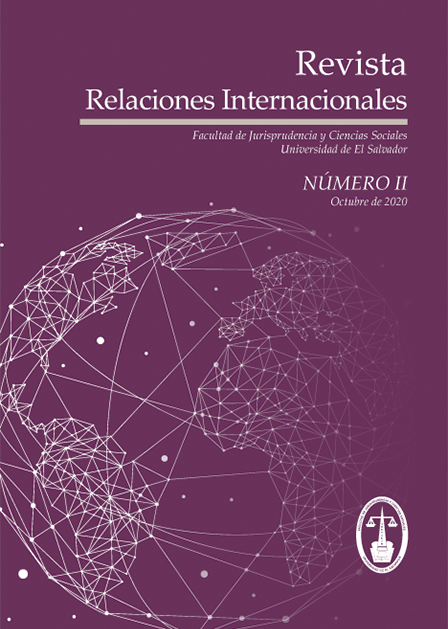China y Estados Unidos, un binomio de poder en el orden mundial, 2010-2019. ¿Oportunidad o amenaza para la seguridad centroamericana?
Palabras clave:
China, Estados Unidos, Centroamérica, Amenazas, Seguridad, Poder, Orden Mundial, Geopolítica, Política Internacional, Relaciones InternacionalesResumen
El orden mundial, visto desde diferentes polos, el militar, político y económico, tiene desde los últimos 10 años tres referentes claves en la comunidad internacional, Rusia, China y Estados Unidos. Estos países, después de la guerra fría y un proceso histórico de reordenamiento económico, han crecido considerablemente en su influencia política, de tal modo que dicha expansión ha llegado hasta la región latinoamericana; dónde, aunque no se muestre de forma evidente, Centroamérica puede ser un territorio geopolítico clave para dicho alcance, específicamente en los intereses de China y Estados Unidos. Ante tal influencia internacional ejercida por los Estados en cuestión y la situación política y social interna, ha provocado que la institucionalidad centroamericana se vea inmersa en una situación inestable. Esto ha dado paso que, en cierta forma, la región se vea involucrada en mecanismos comerciales, económicos o financieros, que la han atado políticamente en función de los intereses internacionales, los cuales van desde seguridad, recursos naturales, elementos logísticos entre otros. En ese sentido, más allá de percibir dichos vínculos como amenazas, se deben generar mecanismos diplomáticos e institucionales en conjunto para poder afrontar de manera coordinada dicha situación y poder convertirla así, en una oportunidad de desarrollo. Centroamérica, pasa por una etapa clave para equilibrar sus intereses y la posición geopolítica que puede ocupar en esa dicotomía de poder; sin embargo, es necesario alinear intereses e identidades políticas a fin de tener una visión coordinada de la geoestrategia mundial y las capacidades que se poseen y que pueden ser traducidas en oportunidades de seguridad en el sistema internacional.
Descargas
Referencias
Alex Gray, “The World’s 10 Biggest Economies in 2017,” World Economic Forum, 2017, https://www.weforum.org/agenda/2017/03/worlds-biggest-economies-in-2017/.
Alianza para la Prosperidad del Triángulo Norte. “Lineamientos Del Plan de La Alianza Para La Prosperidad Del Triángulo Norte,” 2014. https://issuu.com/presidenciasv/docs/lineamientos_del_plan_de_la_alianza
Allen Forbes, “China Encabeza Nuevo Orden Mundial,” Opinión, La Nación, 2013.
Bjorn Moller., “The Concept of Security: The Pros and Cons of Expansion and Contraction,” IPRA Secretary General 36, no. 18 (2000): 25.
Christopher Woody and Jenny Cheng, “Here’s the Hardware the World’s Top 25 Militaries Have in Their Arsenals,” Business Insider, 2019, https://www.businessinsider.com/here-are-the-worlds-most-powerful-militaries-2018-2.
Colin S. Gray, Hard Power and Soft Power: The Utility of Military Force as an Instrument of Policy in the 21st Century (Carlisle, PA: Strategic Studies Institute, 2011).
Cristina De Esperanza, “Entre China y Estados Unidos: El Dilema de Australia,” El Orden Mundial, enero 2019, https://elordenmundial.com/entre-china-y-estados-unidos-el-dilema-de-australia/.
Dilip Hiro, After Empire, the Birth of a Multipolar World (New York: Nation Books, 2010), 180.
Erich de la Fuente, La Política Exterior de Los Estados Unidos Hacia América Latina En La Era Trump, (Madrid: Llorente & Cuenca, 2017). https://ideas.llorenteycuenca.com/wp-content/uploads/sites/5/2017/07/170720_DI_Informe_Politica_Exterior_EEuu_LATAM_Trump_ESP_OK.pdf
Erika Gólcher, “El reto centroamericano ante un mundo en transición”, Revista Estudios, No.11 (1994). https://dialnet.unirioja.es/servlet/articulo?codigo=6135147
Eugenio Bregolat, “Made in China 2025.” Estudios de Política Exterior No.185 (2018): 0–2. https://www.politicaexterior.com/articulos/politica-exterior/made-in-china-2025/.
Expansión, “Comparar Economía Países: Estados unidos vs China,” Datos Macro, 2019, https://datosmacro.expansion.com/paises/comparar/usa/china.
Fernando Arancón, “Los Nuevos Canales En Centroamérica: El Último Pulso de China,” El Orden Mundial, Julio 2014, https://elordenmundial.com/los-nuevos-canales-en-centroamerica/.
Focus Economics, “The World’s Top 10 Largest Economies,” Economic Forecasts from the World ́s Leading Economists, 2019, https://www.focus-economics.com/blog/the-largest-economies-in-the-world.
Gobierno de China, “Documento sobre la Política de China Hacia América Latina y el Caribe (2016)”. https://www.fmprc.gov.cn/esp/wjdt/wjzc/t1418256.shtml
Greg Colton, “US National Defence Strategy May Force Australia Get Fence,” Lowy Institute - The Interpreter, January 2018, http://lowyinstitute.org/the-interpreter/us-national-defence-strategy-may-force-australia-get-fence.
Ignacio Bartesaghi, “La Política Exterior de China Desde La Perspectiva e Intereses de América Latina,” (2015): 12. https://www.researchgate.net/publication/292708848_La_politica_exterior_de_China_desde_la_perspectiva_e_intereses_de_America_Latina_1/link/56b0ca0908ae8e372151f306/download
John J. Mearsheimer, “Structural Realism”, en International Relations Theories, 3era. ed. Ed. por Tim Dunne, Milja Kurki y Steve Smith (Oxford: Oxford University Press, 2013), 78.
José Luis Valenzuela Álvarez. “Evolución de La Política Exterior de China Para América Latina,” Revista Relaciones Internacionales, No.53 (2017): 115–33.
Manuel Montobbio, La crisis centroamericana y la construcción de un Nuevo Orden Internacional en América Latina (Fundación CIDOB, 1997), 131–149.
Manuel Muñiz, “La Confusión de Estados unidos En un Mundo Desordenado.” Estudios de Política Exterior, No.170 (2016). https://www.politicaexterior.com/articulos/politica-exterior/la-confusion-de-estados-unidos-en-un-mundo-desordenado/.
Robert Jervis, How Statesmen Think. (Princeton University Press, 2017)
William Choong, “The Revived’ Quad’ and an Opportunity for the US,” International Institute for Strategic Studies (IISS), January 2018, https://www.iiss.org/blogs/analysis/2018/01/revived-quad.
Descargas
Publicado
Número
Sección
Licencia
Derechos de autor 2020 Revista Relaciones Internacionales

Esta obra está bajo una licencia internacional Creative Commons Atribución-NoComercial 4.0.
Los autores ceden los derechos patrimoniales de autor en favor de la Facultad de Jurisprudencia y Ciencias Sociales de la Universidad de El Salvador (a través de Aequus Editorial), para incluir su escrito en Revista Relaciones Internacionales.








